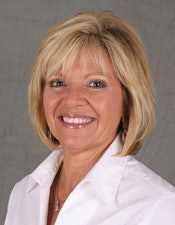
Are you asking the right questions when you conduct risk assessments on your patients? Doing risk assessment right is the focus of Lillian Caperila, RDH, BSDH, who will speak at the American Dental Hygienists' Association meeting in Pittsburgh on June 9.
As the U.S. population ages, dental practices are likely to see more patients older than age 60. What practices might not be aware of is that these patients are likely to have at least one of the following conditions:
 Lillian Caperila, RDH, BSDH, is a professional lecturer and manager of professional education and training at Premier Dental Products.
Lillian Caperila, RDH, BSDH, is a professional lecturer and manager of professional education and training at Premier Dental Products.- Diabetes
- Cardiovascular disease
- Parkinson's disease
- Alzheimer's disease
- Respiratory and chronic obstructive pulmonary disorder (COPD)
- Cancer and undergoing chemotherapy and head and neck radiation
- Xerostomia and related diseases such as Sjögren's disease
Caperila's presentation, which she is giving with pharmacist Tom Viola, RPh, focuses on how these diseases affect dental treatment and how an office can work with a patient to choose appropriate therapies and preventive strategies.
Caperila is a professional lecturer and manager of professional education and training at Premier Dental Products.
Risk assessment
One key issue is the importance of conducting a risk assessment for every patient.
"A risk assessment, like a medical assessment, is a questionnaire that identifies lifestyle behaviors, background, diet, genetics, and the like," she said in an interview with DrBicuspid.com.
The patient's answers allow the dental team to categorize a patient as having a low, moderate, or high risk for dental caries, periodontal disease, and more.
"When you conduct an assessment when patients are new to the practice, it allows you to classify their risk activity," she said. "Doing so changes the scheduling, for instance. You might schedule recall more or less frequently."
What risk assessments also do, Caperila said, is begin discussions with patients about more than just their teeth.
"It also affects the discussion you want to have with the patients about their diet or their behaviors and how those factors can impact their dental care," she said.
“When all you do is ask if anything has changed in their medical history, patients sometimes don't connect the dots.”
When patients first settle into the chair, too many practices stick with the standard question, "Are there any changes in your medical history or medication?" That isn't enough, according to Caperila.
"When all you do is ask if anything has changed in their medical history, patients sometimes don't connect the dots," she said. "For example, if people are taking a new herbal therapy, they don't think that's a change because it's not a medicine."
Having a risk assessment helps remind the dental team to ask questions beyond the standard issues.
"Patients could be doing something that impacts their treatment, which means you start to ask them the questions that are aligned with a proper risk assessment," Caperila said.
Insurance benefits
Caperila noted that, while a full assessment doesn't have to occur at every visit, it can help the team notice issues they might miss, such as dietary changes, health risks or improvements, or new medicines.
"If a patient's mouth is dry or drier than it used to be, that could suggest a risk," she said. "The assessment can change. It's a working document."
If a patient starts showing tooth or root caries at age 60, for instance, when the patient never experienced that earlier, that could indicate a problem, she said. If the practice has a risk assessment on file, then the team can talk with the patient about what changes might be affecting his or her dental health.
"During that dialogue you can discuss how their lifestyle behaviors affect the outcome of their dental care or their risk factors and risk assessment," Caperila said.
Two underappreciated aspects of a risk assessment are the development of a better treatment plan and a more thorough justification of treatment for insurance.
"Not only does it help you develop a better treatment plan, it helps with insurance/third-party payment," Caperila said. "You can show proof to the insurance company that a patient is a high risk."
Caperila urged all practices to take the step and begin using a risk assessment for all patients.
"There are significant advantages to both patient and practice in implementing a risk assessment," she said.



















